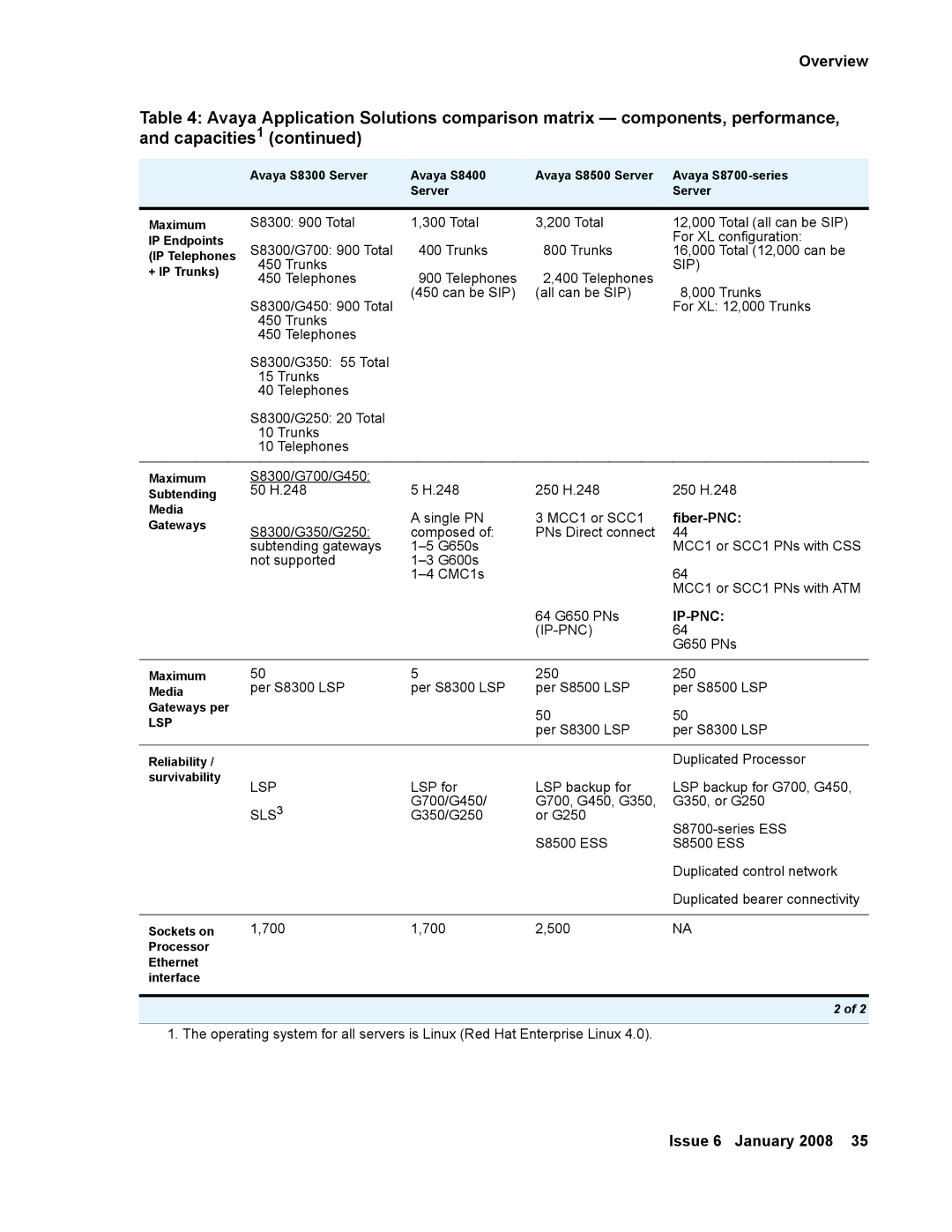Overview
Table 4: Avaya Application Solutions comparison matrix — components, performance, and capacities1 (continued)
| Avaya S8300 Server | Avaya S8400 | Avaya S8500 Server | Avaya | |
|
| Server |
| Server | |
|
|
|
|
| |
Maximum | S8300: 900 Total | 1,300 Total | 3,200 Total | 12,000 Total (all can be SIP) | |
IP Endpoints |
|
|
| For XL configuration: | |
(IP Telephones | S8300/G700: 900 Total | 400 Trunks | 800 Trunks | 16,000 Total (12,000 can be | |
+ IP Trunks) | 450 Trunks |
|
| SIP) | |
450 Telephones | 900 Telephones | 2,400 Telephones |
| ||
| 8,000 Trunks | ||||
| S8300/G450: 900 Total | (450 can be SIP) | (all can be SIP) | ||
|
|
| For XL: 12,000 Trunks | ||
| 450 Trunks |
|
|
| |
| 450 Telephones |
|
|
| |
| S8300/G350: 55 Total |
|
|
| |
| 15 Trunks |
|
|
| |
| 40 Telephones |
|
|
| |
| S8300/G250: 20 Total |
|
|
| |
| 10 Trunks |
|
|
| |
| 10 Telephones |
|
|
| |
|
|
|
|
| |
Maximum | S8300/G700/G450: |
|
|
| |
Subtending | 50 H.248 | 5 H.248 | 250 H.248 | 250 H.248 | |
Media |
| A single PN | 3 MCC1 or SCC1 |
| |
Gateways |
| ||||
S8300/G350/G250: | composed of: | PNs Direct connect | 44 | ||
| |||||
| subtending gateways |
| MCC1 or SCC1 PNs with CSS | ||
| not supported |
| 64 | ||
|
|
| |||
|
|
|
| MCC1 or SCC1 PNs with ATM | |
|
|
| 64 G650 PNs |
| |
|
|
|
| 64 | |
|
|
|
| G650 PNs | |
|
|
|
|
| |
Maximum | 50 | 5 | 250 | 250 | |
Media | per S8300 LSP | per S8300 LSP | per S8500 LSP | per S8500 LSP | |
Gateways per |
|
| 50 | 50 | |
LSP |
|
| |||
|
| per S8300 LSP | per S8300 LSP | ||
|
|
| |||
|
|
|
|
| |
Reliability / |
|
|
| Duplicated Processor | |
survivability | LSP | LSP for | LSP backup for | LSP backup for G700, G450, | |
| |||||
| SLS3 | G700/G450/ | G700, G450, G350, | G350, or G250 | |
| G350/G250 | or G250 | |||
|
|
| S8500 ESS | ||
|
|
| S8500 ESS | ||
|
|
|
| Duplicated control network | |
|
|
|
| Duplicated bearer connectivity | |
|
|
|
|
| |
Sockets on | 1,700 | 1,700 | 2,500 | NA | |
Processor |
|
|
|
| |
Ethernet |
|
|
|
| |
interface |
|
|
|
| |
|
|
|
|
| |
|
|
|
| 2 of 2 | |
|
|
|
|
|
1. The operating system for all servers is Linux (Red Hat Enterprise Linux 4.0).
Issue 6 January 2008 35
